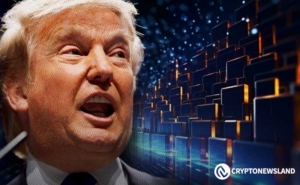Countdown to the election: How do economic indicators and asset classes reveal the likelihood of election outcomes?
Before the election, certain economic and data indicators can predict potential political outcomes and provide insights into voters' priority economic concerns. In addition, asset classes and stock trends often react as the election approaches and quickly adjust after the results are announced.
Author: Revc, Golden Finance
Introduction
The U.S. presidential election voting day is set for November 5, Eastern Time, attracting global financial market attention as the largest political and economic event of the year. On November 2, U.S. Vice President Harris and former President Trump both participated in campaign events in North Carolina. Their private jets were parked just a few dozen meters apart on the same tarmac, highlighting the tense electoral situation, while the fierce competition between Trump and Harris has also triggered price fluctuations in "Trump trades."
The expected results of the U.S. election may not be revealed on the voting day or the following day. Looking back at the last election, due to the close ballots in swing states, it took four days for states to count the votes, with Biden's victory confirmed only on November 7. In this election, the polling gap between Trump and Harris has narrowed, and the counting time in swing states may be longer.
Before the election, certain economic and data indicators can signal potential political outcomes and provide insights into voters' priority economic concerns. Additionally, asset classes and stock trends typically react as the election approaches and adjust quickly after the results are announced.
Overview of relevant indicators and asset changes:
1. Key Economic Indicators Before the Election
Consumer Confidence Index (CCI): This index measures consumers' optimism about the economy. Higher consumer confidence is favorable for the ruling party as it reflects public satisfaction with the economy. Lower confidence may indicate dissatisfaction, benefiting challengers.
As of September 2024, the U.S. Consumer Confidence Index (CCI) decreased to 98.7 (with 1985 as the base value of 100), down from the revised figure of 105.6 in August. This decline reflects consumers' concerns about the labor market, even though the job market remains healthy, with low unemployment, fewer layoffs, and high wage levels.

Analysts point out that this decline may reflect consumers' worries about reduced job opportunities and slowing wage growth, despite the overall economic situation still being considered healthy.
Overall, despite the decline in CCI, consumers' general expectations for the economy remain relatively optimistic, indicating that while there are some short-term concerns, long-term confidence has not been significantly impacted. This situation may reflect consumers' adaptability to the economy and financial markets, as well as their confidence in future policies and economic recovery.
Unemployment Rate: A lower unemployment rate is favorable for the ruling party, indicating economic stability, while a rising unemployment rate is unfavorable for them.

As of October 2024, the U.S. unemployment rate stands at 4.1%. This figure has stabilized compared to previous months, indicating that although external pressures such as hurricanes and new strike activities may temporarily affect job growth, the labor market remains resilient.
Employment conditions influence policy-making regarding taxation, job creation, and economic stimulus. The stable unemployment rate of 4.1% in October 2024 is seen as effective economic policy amid various challenges.
Gross Domestic Product (GDP) Growth: Strong GDP growth is favorable for the ruling party as it indicates economic expansion. Slow or negative growth often raises concerns about economic policy, benefiting challengers.

The annualized GDP growth rate for the U.S. in the third quarter of 2024 was 2.8%. This growth rate indicates robust economic growth but slightly slower compared to previous quarters, suggesting a strong yet cautious expansion. Despite the Federal Reserve's higher borrowing rates implemented in 2022 and 2023 to curb inflation, consumers continue to help drive economic growth.
Inflation Rate: Moderate inflation is usually tolerable, but high inflation close to the election may shift voter sentiment toward candidates promising economic reforms.

The Federal Reserve's preferred inflation measure—the Personal Consumption Expenditures (PCE) index—grew at an annualized rate of only 1.5% last quarter, down from 2.5% in the second quarter, reaching its lowest level in over four years. Excluding the more volatile food and energy prices, the core PCE inflation rate was 2.2%, down from 2.8% in the second quarter.
Despite inflation being under control, average prices remain significantly higher than pre-pandemic levels, leading to dissatisfaction among many Americans and posing challenges for both Harris and Trump's campaign prospects. Most mainstream economists believe that Trump's policy proposals would exacerbate inflation, while Harris's policies would help continue to curb it.
Stock Market Performance: Generally, a strong market supports the ruling party, while a declining market may harm their prospects. Specific indices like the S&P 500 are often used as predictive indicators: if the market rises in the months leading up to the election, historically, the incumbent has a greater chance of winning.

The S&P 500 has historically been a barometer of election outcomes, with positive trends in the three months leading up to the election typically indicating victory for the incumbent party. This pattern has applied to 20 out of the last 24 presidential elections, suggesting a strong correlation between the economic sentiment reflected by the S&P 500 and voter preferences. However, the current U.S. stock market is experiencing a bubble related to the AI industry, which may affect the correlation of data and indicators.
As we enter election week, the index has risen nearly 20% year-to-date, which can be interpreted as a favorable market signal for the ruling party or a reflection of broader economic confidence.
Despite the significant market rise, there was a noticeable decline in the week leading up to the election, with the S&P 500 dropping 1.37% and the Nasdaq index falling 1.5%. This may indicate that investors are feeling nervous at the last minute or repositioning based on potential policy changes after the election.
2. Assets and Stocks Reflecting Election Outcomes
Treasury Yields and Bonds: Bond yields can quickly reflect expected changes in fiscal policy. For example, if a candidate supporting spending wins, yields may rise due to anticipated government borrowing increases. Conversely, if the expected winner is fiscally conservative, yields may stabilize or decline.

Treasury yields, especially the 10-year Treasury yield, have experienced volatility in 2024. Yields rose before November, which can be interpreted in various ways. Market observers believe this may reflect expectations of a shift in economic policy after the election, especially if there are signs or signals indicating a potential Republican victory, historically associated with different fiscal policies that could affect yields.
The bond market, particularly the performance of Treasuries and other fixed-income securities, tends to react to anticipated policy changes. If the market is pricing in a Republican victory, it may imply expectations for fiscal policy changes such as tax cuts or regulatory reforms, which traditionally could lead to rising yields due to increased borrowing and rising inflation expectations. Conversely, a Democratic victory may bring different fiscal strategies, potentially impacting bond yields differently through spending plans or tax policies.
Tech Stocks: Technology companies often respond to potential regulatory changes, especially regarding antitrust issues or data privacy regulations. If a candidate is perceived to be likely to implement stricter regulations, tech stocks may face volatility.

The Nasdaq 100 index includes many of the largest technology and internet companies, which are particularly sensitive to policy changes that may affect innovation, taxation, and regulation.
Historically, strong performance in the months leading up to the election often predicts victory for the ruling party. A significant decline in market indices before the election may reflect investor caution or repositioning in anticipation of policy shifts. Election years typically yield positive returns for the Nasdaq 100 index, with particularly strong performance in November due to the resolution of election uncertainties.
Gold and Safe-Haven Assets: If the election triggers economic uncertainty or geopolitical tensions, investors may turn to safe-haven assets like gold. Gold prices often reflect an increase in risk-averse sentiment.

Gold has historically been viewed as a safe-haven asset, often responding to geopolitical events, economic policy uncertainty, and market sentiment, all of which tend to intensify during elections. The 2024 U.S. election, set against a backdrop of political tension, economic policy debates, and global geopolitical changes, has led to a significant rise in gold prices as investors seek to avoid potential economic turmoil.
Expectations regarding the election results have driven gold prices up, reflecting investors' anxiety and desire to hedge against uncertainty. This pattern aligns with gold's performance in previous election years, although 2024 is shaping up to be a year of significant price increases, potentially indicating deeper economic concerns or expectations for more impactful policy changes.
Historically, in the period following the election, as uncertainty dissipates, gold prices may stabilize or even decline slightly, a phenomenon known as the "election cycle" for gold, where prices may peak before the election and then pull back. However, if the election results lead to long-term policy uncertainty or economic instability, gold may still become a favored asset, potentially maintaining or even increasing its value.
If the election results are expected to weaken the dollar or promote inflation, for example, through increased spending or geopolitical tensions affecting the dollar's dominance, gold may benefit. Conversely, if policies favor a stronger dollar, lower inflation, or economic stability, gold may experience a pullback.
3. Crypto Assets
Bitcoin and Other Cryptocurrencies: Cryptocurrencies can serve as an alternative means to hedge against economic and political uncertainty. Regulatory stances may significantly impact the market. Favorable candidates may promote growth, while regulatory threats may cause volatility.

With just one day left until the U.S. election results are announced, the crypto market has become increasingly volatile, with significant price fluctuations in Bitcoin and other cryptocurrencies leading to mass liquidations of contract users. In the past 24 hours, crypto market users faced liquidations amounting to as much as $350 million.
Over the past week, Bitcoin's price has generally trended downward but has also seen intraday rebounds, posing liquidation risks for both long and short positions. It is expected that Bitcoin will continue to exhibit bilateral volatility before the election results are announced, potentially followed by a unidirectional trend. If Trump wins, Bitcoin is more likely to rise; conversely, it may continue to pull back if Harris wins.
4. Foreign Exchange Market
U.S. Dollar: The dollar typically reflects broader market expectations regarding economic policy. If the election results imply increased federal spending or potential shifts in trade policy, it may lead to dollar fluctuations.

The dollar has shown strength before the election, possibly due to risk-averse sentiment or expectations of significant policy changes. However, its performance after the election may depend on whether Trump or Harris wins, with historical data showing differing outcomes. Trump's victory may have already strengthened the dollar due to expectations of deregulation and potentially more aggressive fiscal policies, while a Harris victory may initially weaken the dollar due to concerns about policy continuity or new regulations.
Conclusion
From consumer confidence indices to unemployment rates, GDP growth, and core inflation rates, current data provides support for the ruling party represented by Harris while also offering space for criticism from Trump. Despite a slight decline in consumer confidence, the resilient job market, steady GDP growth, and controlled inflation present favorable conditions for the current government.
Markets such as stocks, bonds, tech stocks, and gold show different trends—stock market volatility indicates investor caution, rising bond yields reflect expectations for fiscal policy adjustments, and gold as a safe-haven asset is favored amid increasing uncertainty. The performance of cryptocurrencies reflects market concerns about potential regulatory changes stemming from the election.
From financial markets to the general psychological state of investors, the current economic signals provide a window for predicting election outcomes and highlight the complexity and volatility of global markets in an election year.
Disclaimer: The content of this article solely reflects the author's opinion and does not represent the platform in any capacity. This article is not intended to serve as a reference for making investment decisions.
You may also like
Shibarium Devs Connect with Core Team via New Channel

Bitcoin Clings to $74K: Analyzing BTC’s Ability to Ward Off Further Decline
Stability at $74K: How 50,000 BTC Holders are Supporting Bitcoin's Resistance Against Further Dips

Donald Trump’s Memecoin to Face $320 Million Token Unlock as Price Dips

33% of French looking to buy crypto in 2025 but Italians are even more bullish
Share link:In this post: A third of French people intend to purchase cryptocurrencies this year. New study shows Italians as most bullish among surveyed nations in Europe. The crypto sector’s growing legitimacy helps attract more investors, researchers say.
